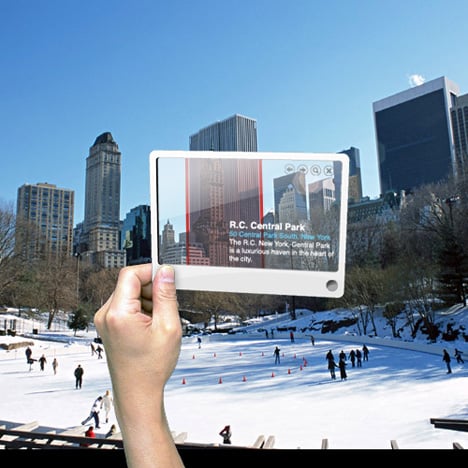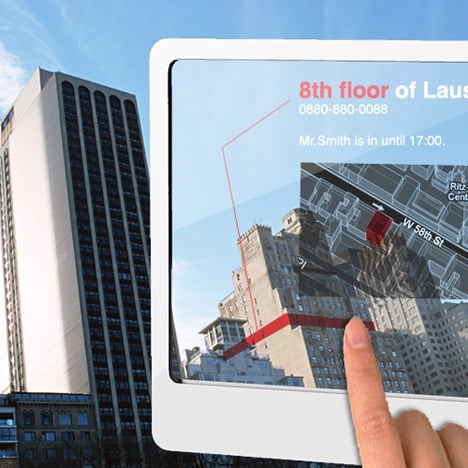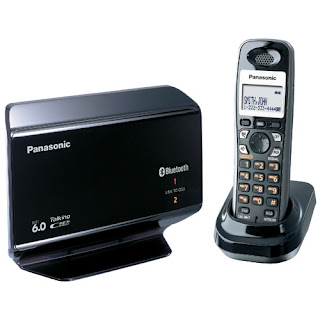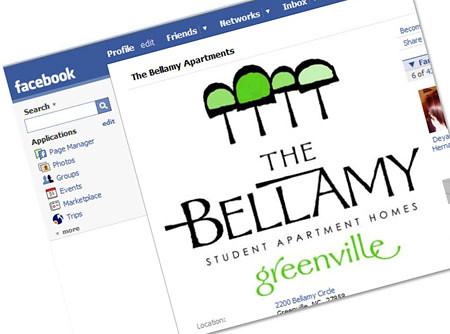There are lots of creative folks out there trying to improve the property tour experience through technology ... probably the best idea I've seen yet is the Flip video handout suggested by Lisa Trosien and Eric Brown.
No doubt, the Flip is a great idea, but there's a new technology on the horizon that trumps it, hands down -- transparent electronics.
Check out these photos of one concept based on the technology, and let your wheels start turning:



This is a concept ultra-connected device that incorporates a camera/scanner, GPS and Internet connectivity, literally putting a world of information in the palm of your hand. Self-guided tours for prospects, neighborhood guides for new residents, an instant interface between architects and contractors ... something like this has SERIOUS potential across multiple aspects of our industry.
Researchers predict we may see commercial products with the see-through technology in as little as 3-4 years. By that time, we might see the credit markets free up enough to get some new developments out of the ground.
Via Yanko Design.
Wednesday, December 17, 2008
Property Tours Will Never Be the Same
Wednesday, November 26, 2008
Retrofitting Your Property: Taking a Different Approach
I'm late posting this, but I wanted to share the presentation I gave last week at the NMHC's Apartment Technology Conference.
The topic was "Voice, Video, and Data Infrastructure: Retrofitting Existing Properties" -- I sat on a panel with Mike Kolb of Cautela Solutions and Scott Skokan of Bozzuto. Mike knows a heck of a lot more than I do about the nuts and bolts and dollar figures that go into the actual upgrade of a property's network, but my job was to frame the conversation in terms of what residents expect when it comes to technology today.
Here are the slides:
The basic premise is that our residents see advancing technology all around them ... except in their apartment, in many cases. When you're considering the retrofit of a property's wiring, make sure you are asking the right questions, considering your residents' expectations and most importantly, thinking about how long you expect the upgrades to last.
Wi-Fi and cellular coverage were major concerns throughout the conversation, and measuring the return on any investment in infrastructure is always a question. It also seemed as if there is a groundswell developing for a technology rating standard (similar to the LEED system) for apartment communities.
Of course, there's a whole lot more that goes into it than just these few items. Feel free to post your questions, comments or horror stories about property wiring retrofits in the comments, on the Multifamily Technology discussion boards, or contact Mike Kolb or me anytime.
Thanks to Larry Kessler and NMHC for giving me the opportunity to speak.
Posted by Mike Whaling View Comments
Tags: Apartment Technology Conference, apartments, home technologies, multifamily, NMHC, retrofit, structured cabling, technology, telecom, video, wiring
Monday, October 20, 2008
Explaining the DTV Transition
This PSA illustrates how easy it is to get ready for the upcoming digital transition:
See? Simple! (At least this all happens after the Super Bowl...)
Posted by Mike Whaling View Comments
Tags: digital, DTV, flat-panel tvs, home technologies, technology, transition, video
Friday, September 05, 2008
Expanding Our Reach
First, I'd like to thank each of you for your continued interest in this site. I certainly don't dedicate enough time to it, but I try to make sure that information still gets out. In addition to the main blog, I also post information on Twitter and Delicious -- both feeds are available in the columns on the right side of the page.
Our LinkedIn group is close to 300 members, even thought I've done very little to promote it. This brings me to the good news! LinkedIn has finally improved their group functionality -- now, discussions and communication within the group is possible. I understand that there are more improvements ahead as well. (For one, they just announced an interesting partnership with CNBC.)
Additionally, we also have established a group page on Facebook -- it's also off to a good start. Here are the links to the group pages:
LinkedIn group page: www.linkedin.com/groups?gid=40421
Facebook group page: www.facebook.com/group.php?gid=18585313267
I invite you to join us on either or both of these sites. If you get something out of it, share it with a friend or colleague. I look forward to your input and ideas.
Sunday, July 27, 2008
One More Reason to Dump the Landline
This one isn't meant to be profound... just more evidence of growing consumer trends that affect our industry.
We already know that the landline telephone is dying a slow death in apartment buildings across the country. Many people have found digital phone and VoIP to be much cheaper and just as reliable. Then there are the millions of people who have dropped their landline entirely in favor of using their cell phone exclusively.
Well, one of my colleagues came across something in the electronics store this week that should make that move to cell-only even easier: 
Although this might look like your regular cordless phone, this new device from Panasonic uses the box pictured to connect to any Bluetooth-enabled cell phone.
From the Panasonic website: "...there's a better way to make and receive calls at home with ultimate comfort and convenience. Panasonic Link-to-Cell uses Bluetooth® technology to connect your cell calls to your home handset. No more running for your cell, walking around for good reception, or cradling that little phone on your shoulder."
Supposedly, once you successfully link the system to your cell phone, from then foward, the handsets will automatically connect to your cell phone as long as it's within 30' of the base unit. You can link up to two cell phones to the system, and your cell phone(s) can charge while using the handset. Caller ID and custom ring tones let you tell who is calling, and on which phone.
Fixed-mobile convergence is making its way into many businesses, and there's a case to be made for it in the home (which potentially flips the landline argument on its side). But at least for now, the trend in the home is more bad news for the landline. Personally, I know I haven't used a landline since 1999 -- now with a device like this, it makes it even easier to avoid the landline and still get the phone service I expect.
(One question I need to think about more is, does multifamily need to think more about interesting uses for Bluetooth throughout our communities? Any thoughts on this? I may have to explore it further in a future post...)
Posted by Mike Whaling View Comments
Tags: Bluetooth, cell phones, home technologies, technology, telephone
Thursday, June 12, 2008
Get That New TV Installed Tomorrow
Looking for a reliable way to ensure that your residents don't gouge huge holes in the wall the next time they try to hang their new LCD TV on the wall?  Then check out a service called Zip Express. Zip Express typically partners with retail outlets (in-store and online) -- they provide nationwide next-day and five-day installation options for consumers, regardless of where they bought the goods. Depending on the item, the prices range from $199 for a standard Home Theater system to $399 for an on-the-wall TV installation package, which is very competitive when compared to the giants like Geek Squad.
Then check out a service called Zip Express. Zip Express typically partners with retail outlets (in-store and online) -- they provide nationwide next-day and five-day installation options for consumers, regardless of where they bought the goods. Depending on the item, the prices range from $199 for a standard Home Theater system to $399 for an on-the-wall TV installation package, which is very competitive when compared to the giants like Geek Squad.
One refreshing feature is that Zip Express guarantees the customer will be given a ONE HOUR window of time for the installer to arrive. It's easy to schedule online, and the installers take all the trash away with them. They can even show the customer how to program and use the new remote! (Of course, it's $149 for Universal Remote programming which includes reviewing the existing TV and A/V components to make sure that they are compatible with the remote control; programming primary commands for up to 8 devices; and training the customer.) No word on pricing to get rid of the flashing "12:00" for those of us who still have a VCR sitting next to our TiVo.![]()
I could see a service like this working very well for apartment communities in some markets -- installation could be offered as part of technology concierge/move-in package:
"Hey new resident, not only do we have all these great technology amenities here, but we also understand that you'll be bringing a truckload of your own gear. Let us help you set it all up while you're getting settled in."They get convenient setup on their schedule, you get a few bucks in your pocket. Reseller opportunities are available if you're interested.
Could this could work in apartment communities? Let me know what you think.
Posted by Mike Whaling View Comments
Tags: consumer electronics, customer service, flat-panel tvs, home technologies, home theater, installation
Tuesday, June 10, 2008
Multifamily Technology at the NAA Education Conference
I'm excited to be moderating a panel at this year's Education Conference, held at the end of the month here in Orlando. The session is titled "Tech-Savvy Residents Expect Tech-Savvy Homes."
My job will be easy, primarily because I'll be sitting next to some fantastic panelists: Henry Pye from JPI, Steve Sadler from Post Properties and Dave Hanchette from Russound. Henry and Steve are multifamily veterans that do nothing but eat, drink and sleep technology, and Dave is a home technology expert who brings great perspective from the electronics industry. These guys will cover the latest trends in apartment technology – focusing on real examples and strategies that will attract tech-savvy residents. Between the three of them, they've seen it all and will be able to share incredible opinions and insights that we all will learn from.
That said, I'm officially recruiting the help of the MT 360° community... If you have a question about all things technology that affect our industry, I want to hear it. Send me an email or a tweet, or just leave it in the comments below -- I'll give credit where it's due for any questions I'm able to use during the session. And if you'll be in Orlando for the event, please let me know -- it's always great to meet new folks and share ideas.
Now let's hear those questions!
Posted by Mike Whaling View Comments
Tags: amenities, apartments, consumer electronics, home technologies, multifamily, NAA, technology, trends
Thursday, May 22, 2008
Energy Management Options
 Mike Brewer's post today on his Property Management blog inspired me to run through some of the other energy management options available on the market today.
Mike Brewer's post today on his Property Management blog inspired me to run through some of the other energy management options available on the market today.
The Home Joule (pictured) is a slick little device that ConsumerPowerline is offering in the New York area.
It analyzes energy price data from the utility company and usage data for each user, then provides a display to the user that changes color and provides other indicators that help determine if energy consumption needs to be adjusted. It all operates on a pager network. Just as messages to specific pagers go only to those users, so do the energy signals find their way to the right Joules.
Companies like Control4, HAI, Honeywell and others have thermostats that are not only programmable, but accessible via the Internet. That means they can be programmed and monitored from the leasing center or a corporate office, which could come in handy for vacant units. The ability to set temperature ranges -- and email/text alerts when things aren't as they should be -- could be a huge benefit for apartment operations teams.
The unit pictured below is from Proliphix -- it's actually an IP-addressable device, so it doesn't require any extra adapters or modules to get it connected to the network. The data can be accessed from an individual webpage, or can be ported to a custom management portal ... I could see this integrating with property management software programs. (Put a unit in 'Vacant' mode upon move-out.)
Most of these devices cost significantly more than regular programmable thermostats, which has prevented them from taking off in the multifamily industry. For example the cheapest I could find online for one of the Cent-a-Meters that Mike covered was $152 each.
However, as the price of energy rises and the prices of electronics continue to fall, these types of solutions will surely continue to gain traction. There's a real ROI case to be made here, not to mention a resident-empowering "be green... take control of your energy" message that marketers could certainly run with.
Do you have other energy control solutions that you're using in your community? Do prospects respond well to them? Do residents actually use them? What would it take for you to switch to a more manageable solution like this?
Thanks for getting the conversation started, Mike!
Wednesday, May 21, 2008
Poll: Would You Use a Multifamily Technology Network?
The Multifamily Technology Group on LinkedIn is growing fast, but there really is no good way for group members to communicate with each other to get questions answered or opinions about new technologies. Let's get the conversation started!
Posted by Mike Whaling View Comments
Tags: communication, community, groups, networking, social networks, technology
Tuesday, May 13, 2008
Google Maps Add More Features
In addition to Wikipedia articles, Google Maps have now added photos through one of Google's photo sites, Panoramio.
On Google Maps, you’ll see there is now a “More” button next to “Street View”" and “Traffic.” If you click on it after getting a map, you will be given the options to select “Photos” or “Wikipedia.” Checking the first option populates the map with geotagged photos provided by Panoramio. The second gives you geocoded Wikipedia articles.
I searched a few cities... In Orlando, I didn't find any apartments communities, although I found entries for a Marriott, a local community college and other landmarks.
The more that Google can populate maps with data like this, the more useful they become. Another example is the relatively new feature that enables you to edit the details of your business listing, and you can even "claim your business" to provide even more information including images, website links and coupons.
I’d really like to see geotagged Flickr photos as an option -- Flickr is a much more popular photo sharing site than Panoramio. As TechCrunch suggests, Yelp reviews would also be cool.
How can apartment marketers use features like this to promote your community? Maybe a photo contest that asks residents to submit and vote on unique photos from around the property or the neighborhood... What else can apartment marketers do? What other useful features could Google add to make their maps to help you promote your business?
From this post:
Wikipedia
Google Maps
Panoramio
Flickr
Yelp
Plan for the View
Location is everything in the multifamily business.
So doesn't it stand to reason that as many details as possible should take location into consideration, even while the property is being designed?
Let's look at an example of what I mean by this.
Below is a building in design that will be built on the New Jersey waterfront, featuring beautiful views of the Manhattan skyline for the community's residents. The property owner realized very early during the design that they wanted this view to be the focal point of as many units as possible.
While the focal point of each unit changes, there are still only a small number of floorplan layouts. This means that two residents living in the same floorplan on opposite sides of the building (North and South in this case) will likely orient their furniture in different ways to take advantage of the best view afforded by their particular unit's location.
Let me show you what I mean... In the image below, the units along the left side of this building face away from the water, offering only a streetfront view: (Click on any of the images below to enlarge.)
The residents in these units are less likely to orient their furniture in one specific way -- the view isn't a primary consideration when determining where the TV, and TV outlet location, will be positioned in the unit. So, we choose the most likely TV location in the living room and locate the wallplate there (Outlet #3 in the middle of this image.):
Now let's consider the units on the opposite side of the building -- the side that offers the premium views of the waterfront and skyline.
The units with this particular floorplan (on Floors 3-8 in this case) are marked in black in the image below:
As you can see, the units are located on both the North and South sides of the building, so the units will feature varying views based on the specific locations throughout the building.
We still want each resident to enjoy the panoramas, both on the screen and out the window. In the plans below, we have identified where each unit is located in the building, considered where residents would locate their couch and other furniture to be able to see the skyline, then located the TV outlets to fit that view-oriented furniture layout. This prevents the resident from running ugly cables across the floor to connect their TV where they want it. You can see how the wiring diagram changes slightly based on where the unit is located in the building:
It's a subtle difference, but without it, residents might be frustrated by misplaced outlet locations that don't consider the context of the surroundings.
With some new mapping and modeling tools, designers are able to determine the approximate view from any unit in a residential building. The low-powered way to do it yourself is to use the 3D features in tools like Microsoft Virtual Earth or Google Earth.
This specific example obviously may not be a concern in many communities, but small details like this will likely save more than a few residents' headaches, regardless of your property's address. How else are you using your property's technologies to complement the community surroundings?
From this post:
Microsoft Virtual Earth
Google Earth
Posted by Mike Whaling View Comments
Tags: architecture, construction, design, low voltage, networking, social networks, wiring
Wednesday, March 05, 2008
Sorry, I Need to Reboot the Treadmill...
Following on the heels of the Nike + Apple announcement yesterday, Samsung and Adidas have teamed up to announce a competitor, the miCoach system.
Nike and Apple originally announced their partnership to create the Nike+ technology more than a year ago -- it's a wireless system that allows some Nike shoes embedded with a sensor to communicate with an Apple iPod Nano.
Now Nike and Apple are making the iPod compatible with gym equipment.
The companies announced Tuesday that they are working with major gym equipment manufacturers, such as Life Fitness and Technogym, to allow users to plug their iPod Nano into cardio equipment to track workouts, set goals and upload the information to the Nike website. The new technology is expected to hit gyms this summer.
Adidas Enters the Race
In the Samsung/Adidas announcement, the miCoach phone is dubbed the "first true sports music mobile."
Just like the Nike+ system, miCoach collects and analyzes personal data and then customizes training plans based on a user's fitness level and specific goals, while offering real-time feedback during a workout using the phone.
A Battleground in Your Clubhouse
While the Samsung system will work over a cellular network, it appears that the Apple solution will communicate directly with the fitness equipment, which probably means that these machines will require an Internet connection in the very near future. Other systems, such as FitLinxx, aleady track users' progress online without the need for an iPod. Keep this in mind if you're designing a new fitness center or refurbishing an exercise room in an existing community.
And while I'm giving you more work ... make sure you review the TV service in these spaces as well. Most fitness equipment is not equipped to receive a secured digital signal, which will render all those treadmill screens dark if you don't install a mini-headend or otherwise address the problem with your video provider.
In any case, it's apparent that the fitness center is becoming a battleground for your health-conscious residents' eyes, ears and wallets. The multifamily industry is just lucky enough to be caught in the crossfire.
Posted by Mike Whaling View Comments
Tags: Apple, broadband, clubhouse, fitness, technology, wireless, wiring
Monday, February 25, 2008
The Multifamily Social Media Toolkit: Part I
I had the opportunity to attend the inaugural NAA Student Housing Conference last week, and the first day of sessions went something like this:
"Millenials are different. Here's how to market to them..."
"Facebook."
"Here's a primer on development."
"MySpace."
"Let's talk operations."
"RealPage. Yardi."
"Facebook."
"Facebook."
"Facebook."
Don't get me wrong ... The conference was excellent, especially for a first-time event. But it struck me that, for all the talk about the largest of the social networking sites frequented by these students, much of the conversation was not incredibly accurate or useful for our marketing purposes.
I'm not going to dispute whether advertising on these sites is effective -- you have measurement tools to tell you that. But in general, I think our industry could use social media tools more effectively if we took some time to learn how other successful companies -- and our residents -- are using these sites.
Start by listening.
Before you jump into the deep end of social networks, you need to know where you stand. What are your residents and others saying about your community online?
Not every resident posts a review on Apartment Ratings. Do some exploring. Search for your property name and neighborhood on Technorati and Google Blogsearch. Set up a search engine alert so you'll be notified anytime another website mentions your community.
Don't do anything yet if you find a negative post ... we'll get to that soon. For now, just listen. Spend some time understanding how your property is perceived online.
While you're getting a handle on your community's web presence, you can also observe others. Find an RSS reader that you like (Google Reader, Bloglines, Sage for Firefox, etc.), and start subscribing to interesting blogs and websites. See how others shape their online story. Every blog has its own persona ... here are a few for you to get started:
Apartment Marketing Blog
MultifamilyPro
The Ground Floor
Seth Godin
Duct Tape Marketing
Pick a few you like, see how others do it, and start to develop a style in your mind that will work for you, your staff and your community. In Part II, we'll start managing your web presence by creating an online voice for your property.
From This Post:
Apartment Ratings
Technorati
Google Blogsearch
Google Alerts
Google Reader
Bloglines
Sage Firefox Plug-in
Wednesday, February 13, 2008
Retailers Provide DTV Education, But Is It Enough?
Lately, the questions from property owners surrounding next year's transition to all-digital TV have started to increase. Don't worry if you not familiar with this ... most of your residents aren't, either.
Both broadcasters and retailers are taking steps to educate consumers. Circuit City was the latest to step in, announcing this week that they would launch a year-long education campaign in advance of the February 2009 switch. This follows announcements from Best Buy and Wal-Mart about similar programs earlier this week.
As part of the effort, Circuit City will present an interactive web forum with Sound & Vision Magazine on Feb. 19. Both Circuit City and Best Buy will start stocking DTV converter boxes the weekend of Feb. 17 in preparation for the first round of coupon buyers.
So I ask, will it be enough? As a property owner or manager, are you making any special efforts to educate your residents (and your staff) that they might be affected by this impending change? Folks expect to be able to come home, fall onto the couch and tune into their favorite programs ... especially now that they'll have something to watch besides reality shows.
And besides your residents, have you looked at how this will affect your own TVs throughout your community? Any TV that is already connected to a set-top box from a cable or satellite company won't be affected by this at all, but my guess is that many properties still have analog TVs in fitness centers, lounges and other common areas that are about to become expensive paperweights.
Now might be the time for a conversation with your video service provider and a quick property audit to determine how much February 17, 2009 will affect you.


